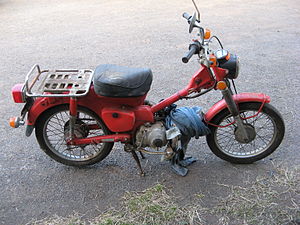- Honda CT90
-
The Honda CT-90 was a small step through motorcycle manufactured by Honda from 1966 to 1979. It was offered in two models - "Trail" or "X" with the main variations being gear ratios and tyre style. Perhaps one of Honda's hidden success stories, this bike sold well worldwide and has a faithful following to this day and has become collectable.
Contents
Basic Information
The CT90 in its classic form was an 89cc 4-stroke air-cooled single with a four-speed transmission and an automatic clutch, coupled with a 1.867:1 ratio reduction box switched into operation using a small lever under the transmission case. The cylinder was nearly horizontal in the step-through tube/stamping frame. The fork was originally a leading link suspension, replaced in 1969 with conventional telescoping-tube suspension.
The CT90 ended production in 1979, replaced the following year by the Honda CT110, which was essentially the same machine bored out to 105cc and weighing slightly more. The 1980 CT110 lacked the reduction box; however, it returned in following years.
Market
Honda targeted hunters, fishermen, commuters and outdoorsmen with the Trail 90. Early ads often featured these bikes in wilderness settings, and they were very well suited for narrow trails, being small, lightweight (around 188 pounds) and with a forgiving suspension. It was ideal for climbing and carrying packs. The four-stroke engine was quiet and almost all models were equipped with spark-arrestor exhausts.
While targeted at off-road uses, this was not a "dirt bike" in the conventional sense. What's more, they could and often were registered for road use and had a top speed in hi-ratio road gear of around 55 mph (89 km/h). Fuel economy was excellent, often around and above 100mpg. In local commuter traffic, they were extremely maneuverable, though they were poorly-suited for highway travel due to limited power, off-road-biased tires, and top speed.
Predecessors
The CT90 "Trail 90" was preceded by the CT200 "Trail 90" which featured a dual-sprocket in the rear, wherein to shift to the low range the operator clipped an extra length of chain into the drive and ran it over a double-size rear-sprocket. The CT200 had an overhead valve engine, not overhead cam. There were also earlier trail models of smaller displacement, including the Trail 55.
Early overhead cam CT90 models also featured the dual sprocket setup rather than the sub-transmission of all later models.
See also
- Honda CT110 which replaced the CT90 in 1980.
- Honda CT series bikes: Trail Cub / Hunter Cub
Categories:- Honda motorcycles
Wikimedia Foundation. 2010.


